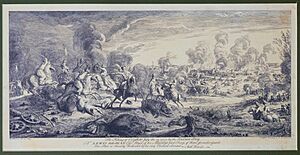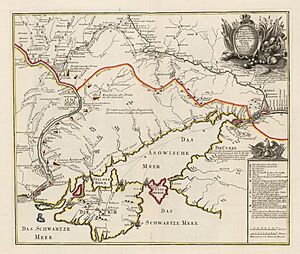Russo-Turkish War (1735–1739) facts for kids
Quick facts for kids Russo-Turkish War of 1735–1739Austro-Turkish War of 1737–1739 |
|||||||||
|---|---|---|---|---|---|---|---|---|---|
| Part of the Russo-Ottoman and Austro-Ottoman war series | |||||||||
 |
|||||||||
|
|||||||||
| Belligerents | |||||||||
| Commanders and leaders | |||||||||
| Casualties and losses | |||||||||
|
|
||||||||
The Russo-Turkish War of 1735–1739 was a big conflict between Russia and the Ottoman Empire. It started because the Ottoman Empire was fighting Persia. Also, Crimean Tatars kept raiding Russian lands. Russia also wanted to gain access to the Black Sea.
In 1737, the Habsburg monarchy (which ruled Austria) joined the war. This part of the conflict is known as the Austro-Turkish War of 1737–1739.
Contents
Preparing for War: Russia's Smart Moves
Before the war began, Russia made sure it had a good position. They signed peace agreements with the Persian Empire between 1732 and 1735. Persia was busy fighting the Ottoman Empire at the time.
Russia also helped Augustus III become the king of Poland in 1735. This was important because France, which supported the Ottomans, wanted someone else to be king. Austria had been Russia's friend since 1726, making them strong allies.
War Begins: Fighting in 1735–1738
The main reason the war started was because Crimean Tatars raided the Cossack Hetmanate in late 1735. The Crimean Khan also led a military trip into the Caucasus region.
In 1736, Russian commanders planned to capture Azov and the Crimean Peninsula. Before the war, Russia made peace with Persia. They gave back all the land they had taken during an earlier war (the Treaty of Ganja).
On May 20, 1736, the Russian Dnieper Army (about 62,000 soldiers) attacked. Led by Field Marshal Burkhard Christoph von Münnich, they stormed the Crimean defenses at Perekop. They then took Bakhchysarai on June 17.
The Crimean khans could not defend their land. Russian armies pushed deep into Crimea in 1736, 1737, and 1738. They forced Tatar leaders into the hills. They also burned cities like Gozlev, Karasubazar, and the khan's palace in Bakhchysarai. The Russians also captured the Ottoman fortress at Azov.
The Ottoman sultan, Mahmud I, removed the Crimean khans Qaplan I Giray and Fetih II Giray. This was because they were not good at defending their territory. However, a terrible epidemic (a widespread disease) hit all sides of the war from 1737 to 1739. Many soldiers got sick and died. Even with his victories, Münnich had to retreat because of disease and lack of supplies.
On June 19, 1736, the Russian Don Army (28,000 soldiers) captured the fortress of Azov. This army was led by General Peter Lacy and supported by the Don Military Flotilla. The 1736 campaign in Crimea ended with Russia pulling back. About 30,000 Russian lives were lost, mostly due to disease and hunger, not fighting.
In July 1737, Münnich's army attacked the Turkish fortress of Ochakov. Lacy's army, with 40,000 men, marched into Crimea and took Karasubazar. But Lacy's troops had to leave Crimea because they ran out of supplies.
In July 1737, the Habsburg monarchy (Austria) joined the war against the Ottoman Empire. However, they lost several battles. These included the Battle of Banja Luka in 1737 and the Battle of Grocka in 1739. They also lost Belgrade after the Ottomans attacked it in 1739.
In August, Russia, Austria, and the Ottoman Empire tried to talk peace in Nemirov. But these talks failed. There were no big battles in 1738. The Russian Army had to leave Ochakov and Kinburn because of a plague outbreak.
End of the War: 1739 and Peace Treaties
In 1739, the Russian army, still led by Field Marshal Münnich, crossed the Dnieper River. They defeated the Turks at Stavuchany. They then took the fortresses of Khotyn (August 19) and Iaşi.
However, Austria was defeated by the Turks at Grocka. Austria then signed its own peace agreement with the Ottoman Empire on August 21. They were probably worried about Russia becoming too strong.
This, along with the threat of a Swedish attack and Ottoman alliances with other countries, forced Russia to sign a peace treaty. Russia signed the Treaty of Niš with Turkey on September 29.
The peace treaty gave Azov to Russia. It also gave Russia control over the Zaporizhia region. In return, Russia gave up its claims to Crimea and Moldova. The war ended without a clear winner for Russia or the Ottomans.
For Austria, the war was a big defeat. Russian forces did much better in battles, but they lost many soldiers to disease. Russia gained access to the Black Sea. However, they were not allowed to keep any warships there.
War Details: Geography and Early Events
The Ottoman Empire had forts along the northern Black Sea coast. Azov stopped the Don Cossacks from entering the Sea of Azov. Kaffa controlled the Crimean Khanate. Or Qapi, behind the Perekop trenches, guarded the entrance to Crimea. Ochakov, at the mouth of the Dnieper River, kept the Dnieper Cossacks out of the Black Sea. Khotyn, on the Dniester River, watched the Polish Commonwealth.
The Crimean Khanate and its allies often raided Poland and Russia. They sold the people they captured to the Turks at Kaffa.
Before 1735: Persia and Raids
In 1722, Russia and Turkey took advantage of Persia's weakness. They captured parts of the Persian Empire. Russia took land near the Caspian Sea, and the Ottomans reached Tabriz. But Nader Shah slowly made Persia strong again. By 1734, Persia was taking back its land. Russia realized it could not hold its gains.
In 1735, the Crimean khan led 80,000 men across the North Caucasus. They went south to Derbent. But he heard about a Russian raid on Crimea and turned back. This Crimean action in the Caucasus was one reason the war started.
In March 1735, Russia made peace with Persia through the Treaty of Ganja. They gave back land and became allies against Turkey. With Crimean troops away and the Turks fighting Persia, Russia saw a chance to attack.
1736: First Attacks on Crimea and Azov
Azov Captured: Around March 30, 1736, General Münnich and 5,000 men began to attack Azov. More soldiers arrived. On May 26, the Turks surrendered Azov.
First Russian Invasion of Crimea: In mid-April, Münnich marched south with 54,000 men. On May 19, Russia had 30,000 troops facing Perekop. On May 20, they broke through the wall. On May 22, the Turks in the Or Qapi fort surrendered.
Russia entered Crimea for the first time. On June 17, they captured Bakhchisarai. The khan’s palace was burned. But Münnich decided to pull back on June 25. Many soldiers were sick with dysentery. There was not enough food or water. Half of the army was lost, mostly from disease. Because of this invasion, the Crimean khan was replaced.
Kinburn Captured: After Perekop was taken, Russian troops captured the fort on the Kinburn Peninsula. Russian prisoners were freed there.
1737: Second Attacks on Crimea and Ochakov
On January 9, 1737, Austria joined the war. This made the Turks move some troops away from the Black Sea. The plan for 1737 was to capture the Turkish fort of Ochakov. Another army would invade Crimea.
Capture of Ochakov: In early April, Münnich left the Kiev area with about 70,000 men. On June 30, they reached Ochakov. Fighting began the next day. On July 3, the town caught fire. The fire spread to a powder storage, which exploded. Thousands of Turks died, and they surrendered that same day.
Münnich left soldiers to hold the fort and returned. In October, the Ottomans tried to take the fort back but failed. The next spring, a plague appeared in the fort. It spread to other areas. In September 1738, Ochakov and Kinburn were emptied to escape the plague.
Second Invasion of Crimea: The goal was to stop the Crimeans from helping Ochakov. Also, to damage Crimea and capture the Turkish fort of Kaffa. On May 3, 1737, Peter Lacy set out. A Turkish fleet attacked Russian supply boats. A storm then destroyed most of the Russian boats.
Instead of attacking the Tatars at Perekop, Lacy built a bridge and crossed to the Arabat Spit. He then crossed to the mainland, making the Crimeans scatter. Lacy went southwest and burned Karasubazar on July 14. Three days later, he decided to pull back. He had lost most of his supplies. The Tatars were regrouping, and sickness was starting. The Turks replaced the Crimean khan because of this invasion.
1738: Third Invasion of Crimea and Western Campaign
The plan for 1738 was to keep the Crimeans busy while Münnich attacked along the Dniester River.
Third Invasion of Crimea: Peter Lacy started with an army about the same size as the year before. He learned that the Crimean khan and 30,000 men were waiting behind Perekop. Instead of attacking Perekop, Lacy crossed the Syvash by wading. They took Or Qapi around early July. They turned south but decided to go home on July 6. There was little food or supplies. Disease was also starting to appear.
Western Campaign: The goal was for Münnich to lead the main army to the Dniester River. He would attack forts there. He reached the Dniester, but on August 6, he stopped the campaign. This was because of Turkish resistance and reports of plague.
1739: Final Campaigns and Peace
Failed Invasion of Crimea: A Russian general named Levashev was supposed to march from Azov. But an epidemic forced him to stop. He returned to Azov because a fire destroyed supplies there. Lacy's force was weaker because many soldiers had been moved to the western campaign. He marched towards Perekop but saw no hope and returned.
Western Campaign: Münnich planned to capture Khotin to help the Austrians. He won the Battle of Stavuchany in August. He took Khotin and marched south to Jassy. There, he learned that Austria had signed a separate peace. This made his position difficult. On September 23, he was ordered to return to Russian territory.
Peace Treaties: The war ended with the Treaty of Belgrade (with Austria) in September and the Treaty of Niš (1739) (with Russia) in October. All sides wanted to end the war because it was costing too much. Russia was also worried about a coming war with Sweden. Russia kept only a demilitarized Azov and Zaporozhye. But it showed that it could reach Moldavia and was a serious threat to Crimea.
Images for kids



